Fluid/Oil/Grease Sale
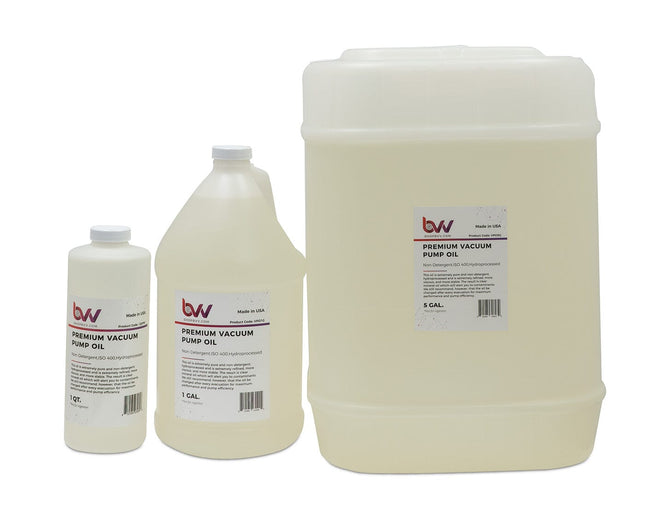
Premium Vacuum Pump Oil
Premium Vacuum Pump Oil For Maximum performance and pump efficiency, change the oil after every evacuation. After evacuation, oil contains contaminants which limit pump efficiency. Premium vacuum pump oil can be used in any vacuum pump to maintain and prolong the life of the pump. Drain immediately after evacuation while pump is warm. Slowly add oil to top of "oil level" line. If oil is to low, you will hear the exhaust baffle chatter. If oil level is too high, excess oil will be blown out of the exhaust. Non detergent-Extra Pure-Hydroprocessed-ISO 400 BVV Vacuum Pump Oil Certificate of Analysis COA BVV Vacuum Pump Oil Safety Data Sheet SDS
$17.11 - $1,354.42

Inland 19 Vacuum Pump Oil for Edwards, Welch, Leybold, Agilent
Inland 19 Vacuum Pump Oil Inland 19 is Inland Vacuum’s recommended general-purpose hydrocarbon fluid for mechanical vacuum pumps used in non-corrosive applications. The manufacturing process of Inland 19 includes molecular distillation, which removes light end fractions present in the fluid and gives it the desired properties: lower vapor pressures, reduced backstreaming, and longer fluid life. As a result, it can be used within the same applications as more expensive diffusion pump oils which would otherwise be contaminated by a vacuum oil of lower grade.A durable, long-lasting mechanical pump fluid, Inland 19 is cost-effective in vacuum applications such as mass spectrometers, electron microscopes, thin-film sputtering, UHV systems, and freeze dry systems. Proper use of this oil effects reduced maintenance costs, improved pumping cycles, and a cleaner vacuum system. Inland 19 MSDS Properties: Molecularly distilled Reduced backstreaming Increased fluid life Low vapor pressure Areas of Application: Mass spectrometry Electron microscopy Thin film sputtering UHV systems Freeze dry systems Other non-corrosive general applications Specifications Inland 19 Vapor Pressure at 25ºC (torr) 1x10-5 Boiling Point at .01 torr (ºC) 112 Viscosity at 40ºC (cSt) 55 Pour Point (ºC) -15 Flash Point (ºC) 213 Fire Point (ºC) 244 Density at 25ºC (g/ml) 0.87
$29.94 - $1,852.00
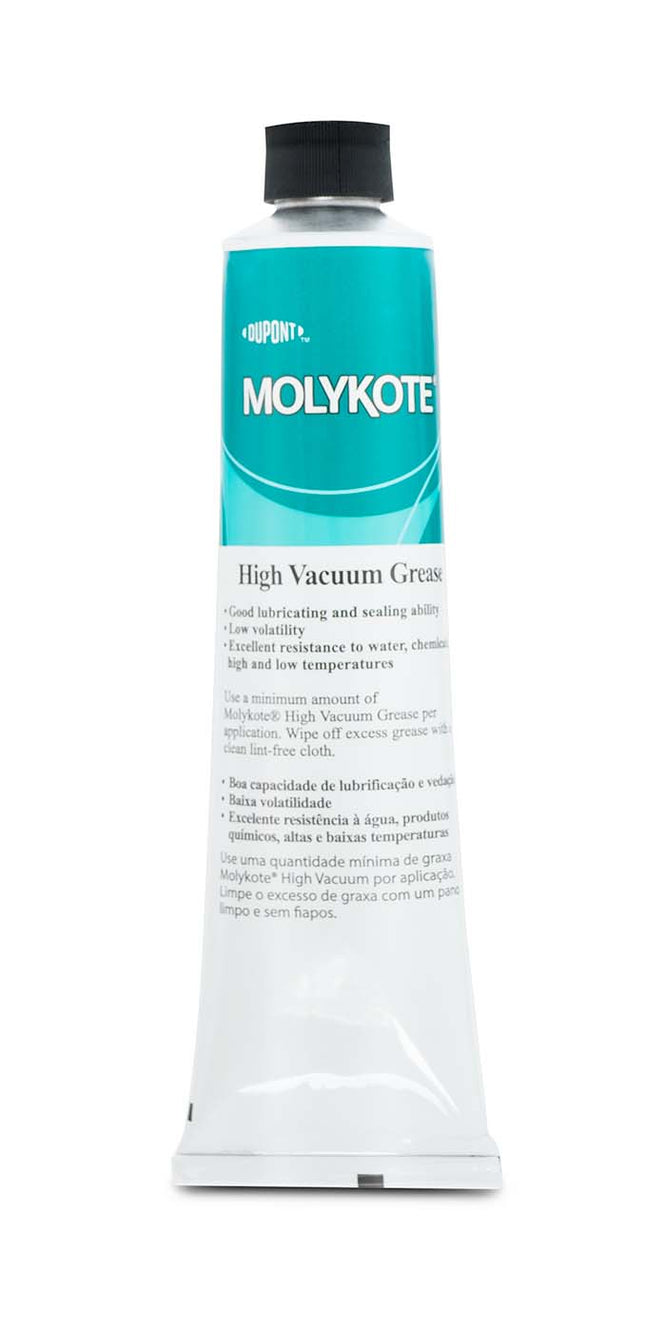
MOLYKOTE® High Vacuum Grease 150g
Key Properties: NLGI Grade 3-4, translucent white, used primarily in sealing vacuum and pressure systems. Molykote Technical Data Sheet Molykote Safety Data Sheet Applications: Seals and lubricates chemical processing equipment. Lubricating plug valves, control valves, flow meter bearings, ceramic plug cocks, fire extinguisher valves, water treating equipment, synthetic rubber gaskets and seals in high-temperature applications. Sealing vacuum and pressure systems. Lubricating O-rings in binoculars and telescopes; prevents fogging of delicate lenses. Performance Benefits: Reduces wear in plastic-to-metal and rubber-to-metal contact Low volatility Excellent resistance to water, chemicals, and high and low temperatures Meets requirements of FDA 21 CFR 175.300 Good chemical resistance Good oxidation resistance Good plastic & rubber compatibility Good water resistance High tack & adhesion High temperature performance Low temperature performance Wide temperature range Product Details: Product type: Compounds Technology: Silicone NLGI Grade: 3-4 Thickener: Silica Low Temp: (C) -40 High Temp: (C) 204 Color Translucent: White
$55.60
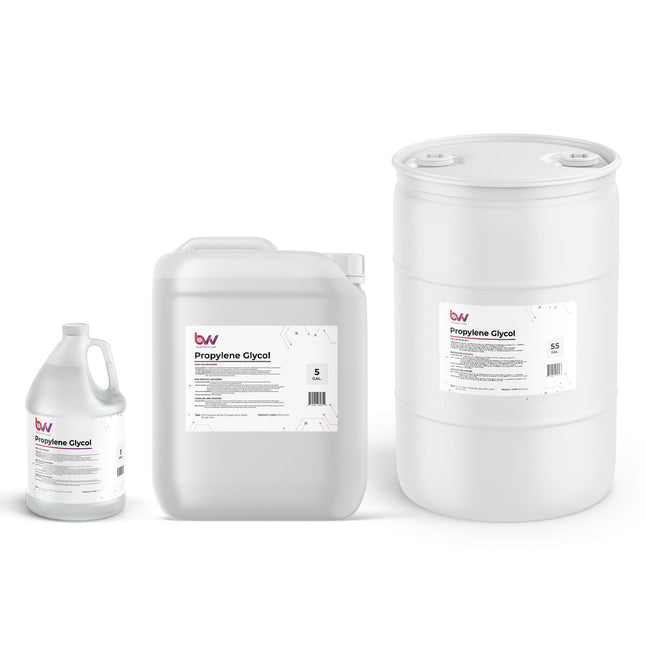
Propylene Glycol Tech Grade 100%
Propylene Glycol Disclaimer: Spigots/Faucets are only compatible with 5 Gallon Jugs and must be purchased separately BVV™ brand propylene glycol is a great heat transfer fluid alternative to water for all processing equipment such as refrigerated or heated circulators and cold traps. This propylene glycol has a freezing point of -74°F and a boiling point of 370°F. BVV™ propylene glycol is considered NOT genetically modified and NOT derived from a genetically modified organism. BVV™ Propylene Glycol SDS BVV™ Propylene Glycol Specification Sheet The expiration date is 2 years from the date of manufacture and when the glycol is kept below 100F and out of direct sunlight.
$41.35 - $6,985.98
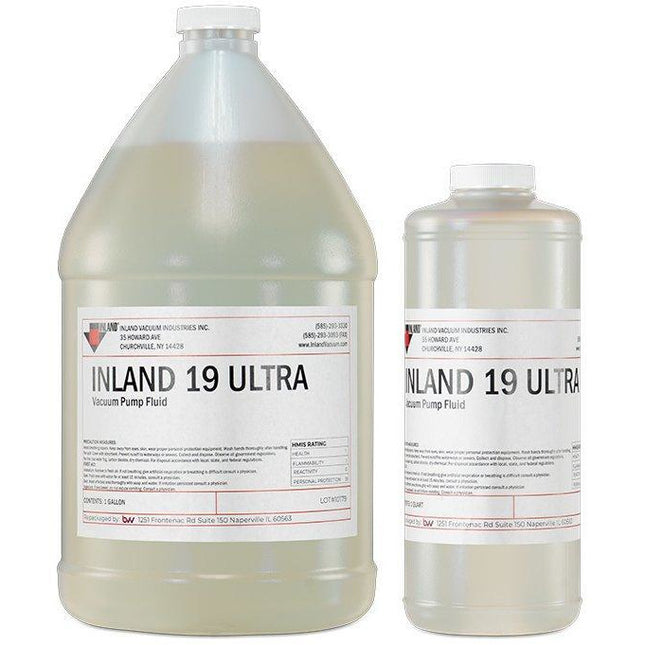
Inland 19 ULTRA® Semi-Synthetic Vacuum Pump Oil
Inland 19 ULTRA® Semi-Synthetic Vacuum Pump Oil Disclaimer: Spigots/Faucets are only compatible with 5 Gallon Jugs and must be purchased separately Inland ULTRA® products are semi-synthetic hydrocarbon fluids designed to endure thermal and chemical stresses much better than standard vacuum pump fluids. The ultra-refined process eliminates nitrogen, sulfur, oxygen, and aromatic hydrocarbons, leaving a clear base stock virtually free of impurities. The additive package will not volatize under thermal stress; the antioxidant will stay in solution and bond up to four times as many radicals as other antioxidants, extending the life of the pump and the fluid. Inland 19 ULTRA® MSDS Properties: Good Thermal Stability Oxidation Resistant Hydrotreated Low Vapor Pressure Long Fluid Life Areas of Application: Mass Spectrometry Electron Microscopy thin Film Sputtering Vacuum Distillation and impregnation UHV Surface Analysis Vacuum Furnaces and Heat Treatment EB Welding Vacuum Tube Evacuation Vacuum Metallization Chemical Pumping Specification Inland 19 ULTRA Vapor Pressure at 25ºC (torr) <1x10-6 Boiling Point at .01 torr (ºC) 166 Viscosity at 40ºC (cSt) 55 Pour Point (ºC) -10 Flash Point (ºC) 247 Fire Point (ºC) Density at 25ºC (g/ml) 0.86 Color clear
$38.49 - $2,744.49
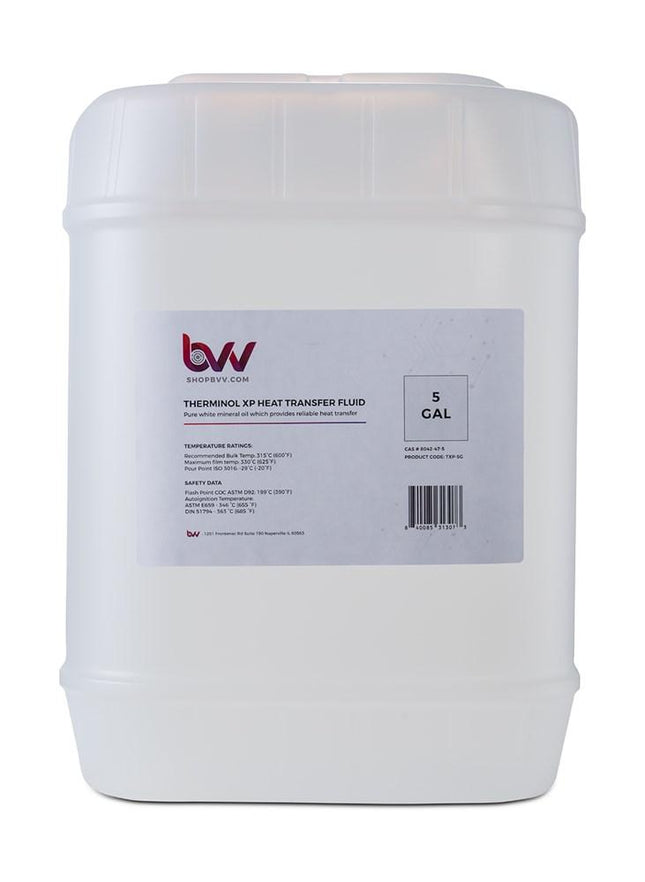
Therminol XP Heat Transfer Fluid
Product description Safety Data Sheet Technical Data Sheet Therminol XP heat transfer fluid is an extremely pure white mineral oil which provides reliable heat transfer. Performance Benefits Low Fouling— The chemical composition of Therminol XP has been carefully selected to minimize system fouling that results from oxidation and degradation of the fluid. Practically Non-Toxic— It meets the purity specifications in U.S. Food and Drug Administration Regulation 21 CFR 172.878 and is listed as a Registered Nonfood Compound by NSF International (Category Code HT-1: Heat transfer fluids - Incidental contact). Thermal Stability—Users can expect many years of reliable, trouble-free operation, even when operating Therminol XP continuously at the recommended bulk temperature of 315°C (600°F). Environmentally Friendly—Therminol XP has outstanding regulatory status for those seeking heat transfer fluids that have minimum environmental reporting requirements. Applications Adhesives Desalination Dryer heating Fatty acid HTF - bakery HTF - deodorizing HTF - deodorizing oil and fat HTF - edible oil HTF - food production HTF - food/feed/beverage processing HTF - production of bioalcohol HTF - production of biodiesel Industrial Peek (polyether ether ketone) Phthalic anhydride Polyester (PET) Specialty and batch chemical production Specialty chemicals Key attributes Environmentally Friendly Low Fouling Practically Non-Toxic Thermal Stability
$213.86 - $5,702.84
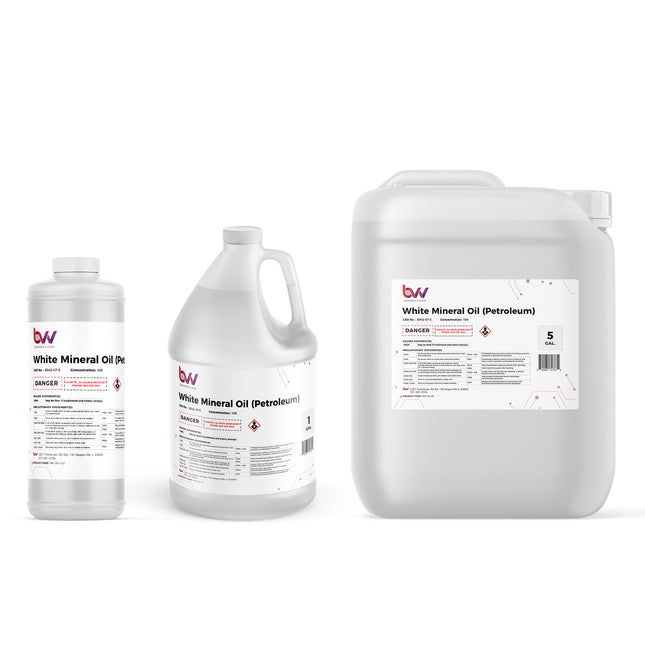
Mineral Oil 7 White NF (USP/NF)
BVV Mineral Oil 7 White NF (USP/NF) Food Grade White mineral oil can be used for many applications. Industrial, cosmetics, and food processing. Our Mineral Oil can be used in direct skin and food contact. Our oil is colorless, odorless and tasteless . This mineral oil can act as a non-conductive coolant, thermal fluid, lubricant, release agent, binder, defoamer, protective coating or float, sealing and polishing agent, dust control agent, and more. It has applications in three main areas: The industrial sector Cosmetics Food processing While those three sectors use this element most widely, it has a variety of other applications. White mineral oil is a standard household item, but has also found uses in some niche markets. The substance is versatile and has many properties making it useful in a range of applications. Food Grade Certified to FDA 21 CFR 172.878 BVV Mineral Oil 7 White NF - COA BVV Mineral Oil 7 White NF - Spec Sheet BVV Mineral Oil 7 White NF - SDS What is a food grade mineral oil? To use mineral oil in food preparation, it must be classified as a food-grade mineral oil. This is vital for health and safety as well as legal compliance. The Food and Drug Administration (FDA) has established standards any 'food-grade' substance must meet for both direct additions to foods and uses that may result in incidental contact with food. The requirements for purity, amount used, and processes vary based on how one uses mineral oil. The United States Pharmacopoeia (USP) and the National Formulary (NF) first created guidelines for the use of mineral oil in manufacturing. The FDA requires that food-grade mineral oil meet USP XX test requirements for readily carbonizable substances, which USP released in 1980, and USP XVII test requirements for sulfur compounds. It also needs to meet the specifications in Volume 45 of the Journal of the Association of Official Analytical Chemists. Mineral oil used as a lubricant for food-processing machinery must be registered with NSF International, an independent global food safety organization, as lubricants for incidental food contact to be used in food-processing plants under the jurisdiction of the U.S. Department of Agriculture (USDA). Other organizations oversee mineral oil use in other industries. For example, the Association of American Feed Control Officials (AAFCO) governs its use as a dust control agent for animal feeds. This classification is different, however, from food-grade mineral oil. Mineral oil used in the production of pharmaceuticals must be considered pharmaceutical-grade. The cosmetics and medical industry use highly refined mineral oil to avoid irritating the skin, eyes, and other body parts. Mineral oil chemical formula Mineral oils coming from crude petroleum oils vary in their make-up and contain complex structures. They include mixtures of straight and branched-chain paraffinic, naphthenic, and aromatic hydrocarbons. Alkanes, which are acyclic saturated hydrocarbons, are a significant component. They are made up of hydrogen and carbon atoms in a tree structure where all the carbon-to-carbon bonds are single. Mineral oil typically contains between 15 and 40 hydrocarbons. Mineral oil attributes Understanding the physical and chemical properties of mineral oil will help you to determine how best to use it in your industrial, food-processing, or other processes. These attributes may differ depending on the type of mineral used, how you use it, and whether any other substances get added to the oil. Mineral oil is a clear, colorless, and odorless liquid. This lack of strong physical qualities helps make it valuable in a variety of applications. Manufacturers can add it to products without changing their color, scent, flavor, or other crucial aspects. Mineral oil is also generally regarded as safe for human consumption, but in limited amounts. These features enable its use in the food processing and pharmaceutical sectors. Refined mineral oil does not clog pores, which allows for its use in cosmetics. Mineral oil has a density of 0.85 grams per milliliter (g/ml), and its specific gravity is 0.845 - 0.905. Its kinematic viscosity is greater than or equal to 38.1 millimeters squared per second (mm2/s). It is insoluble in water. The substance has an initial boiling point of 424.4 degrees Fahrenheit (°F) and a boiling range that extends up to 1189.4 °F. Its flash point is 275.00 °F closed cup and 380.00 °F open cup. It has an auto-ignition temperature of 500 °F, and its heat of combustion is 31.5 kilojoules per gram (kJ/g). As mentioned above, mineral oil has an NFPA flammability rating of one, a health rating of zero, and a reactivity rating of zero, meaning it is not a high fire risk. One of the most beneficial attributes of white mineral oil is its lubrication capabilities. This is the primary reason it has so many industrial, mechanical, food-processing, and medical applications. This property plays a crucial role in many manufacturing and food production processes. Its ability to transfer heat and its non-conductivity enable mineral oil's use as a coolant in a various electronic and mechanical equipment, as well as in industrial processes. Its resistance to water and other liquids, as well as insolubility in water, allow mineral oil to function as a sealant and binder in a variety of products. Safety Mineral oil is not regarded as an especially dangerous substance, but like all chemicals, users should handle it with appropriate care and precautions. A Material Safety Data Sheets (MSDS) for mineral oil may include the following information: Eyes: Mineral oil may cause eye irritation if it comes into contact with them. Flush eyes for several minutes and seek medical attention. Skin: It may cause skin irritation if prolonged contact with skin occurs. Remove contaminated clothing and wash affected areas or shower. Get medical attention if irritation persists. Inhalation: Inhaling mineral oil mist may irritate the respiratory tract and lungs. If this occurs, move to fresh air. Get medical attention if irritation persists. Ingestion: Ingestion can cause gastrointestinal irritation and result in nausea, vomiting, and diarrhea. If conscious, rinse mouth and drink water. Do not induce vomiting. If irritation persists, get medical attention. Mineral oil is combustible but has a low flammability rating. Having a National Fire Protection Association (NFPA) rating of one, means mineral oil must be preheated to ignite. Mineral oil has an instability rating of zero, which means it is stable even under fire conditions, and a health rating of zero, meaning it does not create any additional hazards beyond normal combustibility. You can extinguish a mineral oil fire using water fog, foam, dry chemical powder, or carbon dioxide (CO2) but should not use a water jet as this can spread the fire.If you encounter a spill of mineral oil, keep unnecessary personnel away, wear protective equipment, and absorb the spill with an absorbent material before cleaning the affected surface to remove any residue. Applications for mineral oil Mineral oil is inert, which makes it easy to use. Both consumers and businesses in a range of industries use mineral oil for a variety of applications. The three sectors named above primarily use mineral oil, but it appears across a wide range of industries and applications. Here are some of the most common uses in the industrial, personal care, and food production sectors. Use in cosmetics You can find mineral oil in many different cosmetics products including baby lotions, ointment, make-up remover, sunscreens, hair conditioner, and even tissues. Mineral oil is an ideal base material for many of these products because it is inert, colorless, and odorless. Mineral oils may appear in cosmetics as liquid oils or solid waxes. Some kinds of mineral oils are comedogenic, meaning they clog pores. Because of this, the mineral oil used in skincare and cosmetic products is noncomedogenic and does not clog pores. In fact, cosmetics companies often describe mineral oil as having moisturizing, protective, and cleansing properties for the skin. Additionally, these oils are used to give cosmetic products film-forming and water-repellent features as well as increased firmness. Use in food processing The food processing and preparation industries frequently use mineral oil. Sometimes, manufacturers add mineral oil directly to food. At other times, mineral oil assists in the production process but is not added to food directly. As mentioned earlier, all mineral oil that may come into contact with food must achieve classification as food-grade, and it must be used in accordance with all relevant laws and regulations. Food producers use mineral oil as a: Binder, release agent, or lubricant in bakery products, dehydrated foods, egg white solids, and in tablets or capsules for adding nutrients, flavoring, spices, or for use as a dietary supplement Release agent, sealing agent, and polishing agent in confectioners Protective coating on raw fruits and vegetables Defoamer in vinegar and beet sugar production Dough divider Dust control agent for grains. Binder, release agent, and lubricant in the manufacturing of yeast Mineral oil plays a role in some of the non-food products used to prepare, serve, and eat food. In these situations, the oil should also be food-grade. When applied to cookware, bakeware, and cooking utensils, mineral oil prevents food from sticking to them. People rub it onto the surface of wooden cutting boards, bowls, and utensils to prevent them from absorbing water, which can damage them. Mineral oil also prevents wood-based cooking tools from absorbing food liquids and odors, which makes cleaning easier. It acts as a lubricant for food processing equipment as well. Industrial, mechanical, and electrical uses Mineral oil serves to assist with various industrial, mechanical, and electrical purposes. It is an effective lubricant for industrial equipment and often functions as a processing aid. It is an element that helps make up various substances used in industrial processes, such as lubricants, greases, dyes, polymers, and surface treatment products. Mineral oil also acts as a thermal fluid or non-conductive coolant in various electric components. In refrigerators and oil-based electric heaters, mineral oil is used as a cooling liquid. In switchgear, it serves as an insulator and a coolant to diffuse switching arcs. In the production of plastics, mineral oil is used to control the melt flow rate of finished polymer and act as a release agent. Automotive equipment frequently uses mineral oil, primarily as a component in hydraulic liquids in automotive suspension, as well as in lubricants in brake fluids and motor oil.
$21.39 - $6,985.98
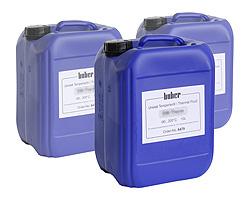
Huber DW-Therm M90.200.02, Heat transfer fluid -90 to 170 °
Huber DW-Therm M90.200.02, Heat transfer fluid -90 to 170 ° DW-Therm is a mixture of isomeric triethoxysilanes and has been developed for hydraulically sealed systems. We recommend the heat transfer fluid DW-Therm for Unistats. DWTherm has a high specific heat capacity and so contributes towards an optimum heat transfer. In addition, DW-Therm covers a large temperature range, and has an impressively long service life. Advantages: Valid only for Unistats Size 10L Broad working range from -90 °C to 200 °C (hydraulically sealed systems) excellent thermooxidative stability at high temperatures Low viscosity at low temperatures Low volatility and pleasant odour Easy handling (no creeping like silicone oils) Good compatibility with silicone oils Insolubile in water and good environmental compability Safety Data Sheet Properties Working temperature °C -90 to 200 Flash Point °C 101 Fire Point °C 112 Viscosity mm2/s (kinematic at 25 °C) 2 Density g/cm3 (at 20 °C) 0,879 Pour Point °C -137 Ignition temperature °C 265 Colour yellowish, clear Thermal expansion coefficient 10-5/K 96,98 Heat conductivity W/(m·K) at 25 °C 0,116 Material incompatibility copper, aluminum,non-ferrous metals
$2,951.22
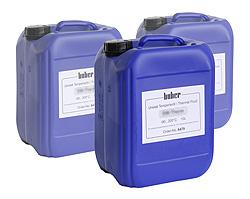
Huber SilOil M60.115/200.05, Heat transfer fluid -60 to 200 °C
Huber SilOil M60.115/200.05, Heat transfer fluid -60 to 200 °C SilOil M60.115/200.05 is a low-viscosity silicone fluid which, as a result of its special property profile, is particularly suitable for use as a cold and heat transfer medium in cryostats, thermostats and heat transfer installations. SilOil M60.115/200.05 can be used in the range from -60 °C to 115 °C (for open systems) and to 200 °C in externally sealed systems (Unistats). It should be borne in mind that, at high temperatures, SilOil M60.115/200.05 can be chemically altered by oxidising media, such as air, or substances with a catalytic effect, such as acids, lyes and various metal compounds. An increase in viscosity, and possibly even gelling of the fluid owing to crosslinking reactions, must be expected in the presence of oxidising agents, while contact with products having a catalytic effect usually induces a process of depolymerisation, resulting in a drop in viscosity Advantages: virtually insolubile in water non-corrosive low setting points and vapour pressures high flash points low toxicit odourless no coking tendency under thermal stress high thermal stability resistance to ageing chlorine free Safety Data Sheet Heat transfer fluid M60.115/200.05 Working temperature °C 60 to 115/200 open/closed systems: -60°C…115°C Unistats (only closed): -60°C…200°C Material: silicon oil Viscosity at 25°C: 5 mm²/s Colour colourless, clear Material incompatibility Silicone rubber
$1,276.01 - $2,281.14
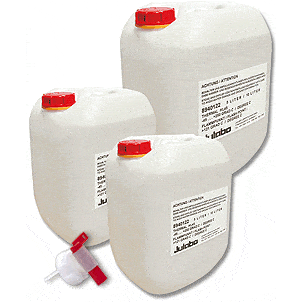
Julabo C2 Thermal Bath Fluid - 10 Liters
Julabo C2 Thermal Bath Fluid JULABO Thermal bath fluids are ideally suited for all of your temperature control applications and guarantee safe and reliable operation. Choosing the proper bath fluid is critical for best results in temperature control. Viscosity, oxidation characteristics and heat transfer of Thermal fluids are specifically matched with each JULABO temperature control unit. C2 Thermal Bath Fluid Product Data Sheet C2 Thermal Bath Fluid SDS JULABO Thermal bath fluids have been carefully selected and are optimized for maximum performance with JULABO instruments. Benefits Low toxicity Low viscosity High stability Minimum odor Good heat conductivity Low corrosion tendency Wide temperature ranges Technical Data Order no. 10 liters 8891400 Working temperature (°C) -90...+60 Flash point (°C) > +75 Fire point (°C) > +430 Viscosity (kinematic at 20 °C in mm²/s) 2 Density (at 20 °C in g/cm³) 0.873 Pour point (°C) -120 Boiling point (°C) 229 Ignition temperature (°C) 430 Color clear
$2,378.08
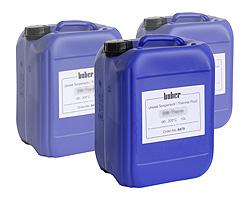
Huber SilOil M40.165/220.10, Heat transfer fluid -40 to 220 °C
Huber SilOil M40.165/220.10, Heat transfer fluid -40 to 220 °C SilOil M40.165/220.10 is a low-viscosity silicone fluid which, as a result of its special property profile, is particularly suitable for use as a cold and heat transfer medium in cryostats, thermostats and heat transfer installations. SilOil M40.165/220.10 can be used in the range from -40 °C to 165 °C and to 220 °C in externally sealed systems (Unistats). It should be borne in mind that, at high temperatures, SilOil M40.165/220.10 can be chemically altered by oxidising media, such as air, or substances with a catalytic effect, such as acids, lyes and various metal compounds. An increase in viscosity, and possibly even gelling of the fluid owing to crosslinking reactions, must be expected in the presence of oxidising agents, while contact with products having a catalytic effect usually induces a process of depolymerisation, resulting in a drop in viscosity. Advantages: Virtually insolubile in water Non-corrosive Low setting points and vapour pressures High flash points Low toxicity No coking tendency under thermal stress High thermal stability Resistance to ageing Chlorine free Safety Data Sheet Heat transfer fluid M20.195/235.20 Working temperature °C -40 to165/220 open/closed systems: -40°C - 165°C Unistats (only closed): -40°C - 220°C Material: silicon oil Viscosity at 25°C: 10 mm²/s Colour colourless, clear Material incompatibility Silicone rubber
$1,276.01 - $2,281.14
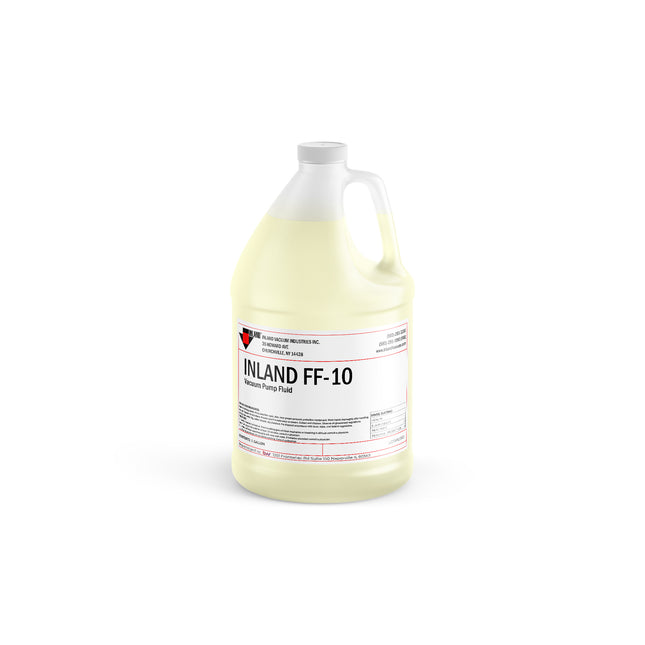
Inland FF-10 Flushing Fluid
Inland FF-10 Flushing Fluid Inland FF-10 is a solvent free hydrocarbon flushing fluid designed to be used as part of a preventive maintenance program. Periodic use of FF-10 will enable the user to remove contaminants and particulates from within all areas of the pump without the worry of contaminating the pump with an expensive solvent Specifications FF-10 Vapor Pressure at 25ºC (torr) 2x10-4 Viscosity at 40ºC (cSt) 28 Viscosity at 100ºC (cSt) 4.5 Flash Point (ºC) 199 Fire Point (ºC) 221 Density at 25ºC (g/ml) 0.85 Inland FF-10 Flushing Fluid Safety Data Sheet SDS
$19.96 - $1,454.22
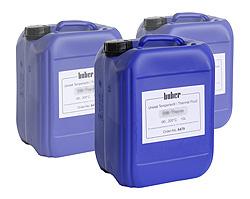
Huber DW-Therm HT P20.340.32 Heat transfer fluid 20 to 340 °C
Huber DW-Therm HT 20 to 340 °C Heat transfer fluid Huber heat transfer fluids are recommended for many temperature control applications because they have the best possible thermodynamic and environmental characteristics. Safe reliable operation relies on compliance with safety standards to ensure optimal results. DW-Therm HT is a mixture of partially hydrogenated naphthalenes. It is especially suited for high temperature applications using hydraulically sealed thermostats. Please note: Valid only for Unistats Safety Data sheet Advantage: broad working range from 20 °C up to 340 °C (hydraulically sealed systems) Long lifetime at high temperatures under inert atmosphere: 3 -4 years Good thermal properties for heat transfer High thermo-oxiation stability Properties Working temperature°C 20 to 340 Flash Point °C 190 Flash Point °C approx. 218 Viscosity mm2/s (kinematic at 25 °C) 32 Density g/cm3,(at 20 °C) 1,043 Pour Point °C -30 Ignition temperature °C 385 Colour orange, clear Thermal expansion coefficient 10-5/K not specified Heat conductivity W/(m·K) at 30 °C 0,130 Material incompatibility not specified
$1,190.47 - $2,053.02
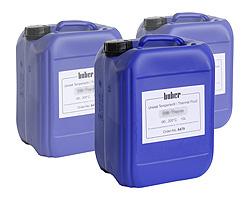
Huber MinOil P20.190.40, Heat transfer fluid 20 to 190 °C
Huber MinOil P20.190.40, Heat transfer fluid 20 to 190 °C P20.190.40 is a high quality mineral oil based heat transfer fluid. It meets the technical safety requirements and tests according to DIN 4754 as well as the recommendations of VDI 3033 (Construction, operation and maintenance of heat transfer systems). Advantages: very good oxidation stability high thermal stability good viscosity-temperature characteristics low tendency to coke extended oil change interval Safety Data Sheet Properties Working temperature °C 20°C…190°C Flash Point °C 190 Fire Point °C not Specified Viscosity mm2/s (kinematic at 25 °C) 40 Density g/cm3 0,86 Pour Point °C > 300 Ignition temperature °C > 300 Color light yellow Thermal expansion coefficient 10-5/K not Specified Heat conductivity W/(m·K) at 25 °C 0,135 Material incompatibility Not Specified
$655.83 - $1,953.22
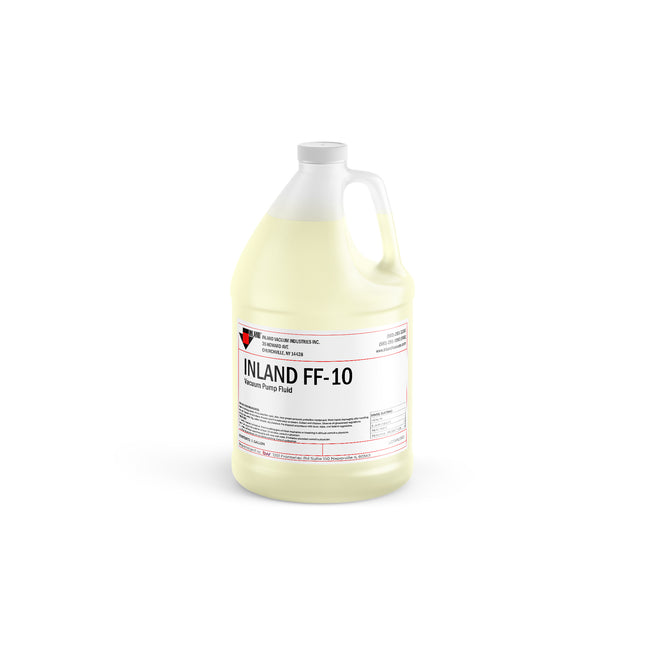
Inland 70 Ultra Vacuum Pump Oil (Edwards Ultragrade 70)
Inland 70 Ultra Vacuum Pump Oil This is oil is a direct replacement for Edwards Ultragrade 70 oil. Specifications Inland 70 Ultra Vapor Pressure @25°C 1x10^-7 torr Viscosity @ 40°C 72 cSt Pour Point: -10°C Flash Point: 249°C Density: 0.86 g/ml Color: Clear Inland 70 Ultra Safety Data Sheet PDF
$24.24 - $2,646.83
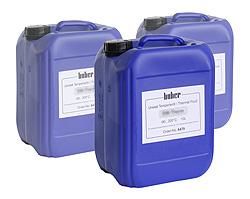
Huber SilOil M80.100/250.03, Heat transfer fluid -80 to 250°C
Huber SilOil M80.100/250.03, Heat transfer fluid -80 to 250°C SilOil M80.100/250.03 is a low-viscosity silicone fluid which, as a result of its special property profile, is particularly suitable for use as a cold and heat transfer medium in cryostats, thermostats and heat transfer installations. SilOil M80.100/250.03 can be used in the range from -80 °C to 100 °C (for open systems) and to 250 °C with externally sealed systems (Unistats). It should be borne in mind that, at high temperatures, SilOil M80.100/250.03 can be chemically altered by oxidizing media, such as air, or substances with a catalytic effect, such as acids, lyes and various metal compounds. An increase in viscosity, and possibly even gelling of the fluid owing to crosslinking reactions, must be expected in the presence of oxidising agents, while contact with products having a catalytic effect usually induces a process of depolymerization, resulting in a drop in viscosity Safety Data Sheet Advantage: virtually insoluble in water non-corrosive low setting points and vapor pressures high flash points low toxicity odorless no coking tendency under thermal stress high thermal stability resistance to ageing chlorine free Heat transfer fluid M80.100/250.03 Working temperature °C -80 to 100/250 open/closed systems: -80°C - 100°C Unistats (only closed): -80°C - 250°C Material: silicon oil Viscosity at 25°C: 7 mm²/s Color colorless, clear Material incompatibility Silicone rubber
$2,694.59 - $5,146.81

Polyethylene Glycol 400 - PEG 400
Polyethylene Glycol 400 Polyethylene glycol 400 has an average molecular weight of 400. It is a clear, viscous liquid at room temperature. APPLICATIONS • Chemical Intermediate• Plasticizer• In cosmetics for preparation of ointments and lotions.• As a mold release agent and lubricant for both natural and synthetic products. Physical Properties Flash point, PMCC, °F 390 Flash point, PMCC, °C 199 Refractive index, 25°C 1.463 Density, g/ml, 20°C (68°F) 1.1254 Weight, lbs/US gal, 20°C (68°F) 9.39 Freezing Range, °F 39-46 Freezing Range, °C 4-8 Viscosity, kinematic cSt at 25°C (77°F) 84 cSt at 98.9°C (210°F) 7.3 Chemical Properties Molecular Weight (range) 380-420 Average number of EO units 8.7 Water Solubility Soluble Potassium acetate, wt% 0.02-0.2 pH, 5% aqueous solution 4.5-7.0 Water, wt% 0.5 max. Color, Pt-Co 50 max. Hydroxyl number, mg KOH/g 267-295 Appearance, 20°C Clear The expiration date is 3 years from the date of manufacture and when the glycol is kept below 100F and out of direct sunlight.
$35.64 - $5,275.13
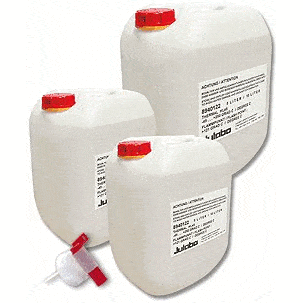
Julabo C5 Thermal Bath Fluid - 10 Liters
Julabo C5 Thermal Bath Fluid JULABO Thermal bath fluids are ideally suited for all of your temperature control applications and guarantee safe and reliable operation. Choosing the proper bath fluid is critical for best results in temperature control. Viscosity, oxidation characteristics and heat transfer of Thermal fluids are specifically matched with each JULABO temperature control unit. C5 Thermal Bath Fluid SDS C5 Thermal Bath Fluid Product Data Sheet JULABO Thermal bath fluids have been carefully selected and are optimized for maximum performance with JULABO instruments. Benefits Low toxicity Low viscosity High stability Minimum odor Good heat conductivity Low corrosion tendency Wide temperature ranges Technical Data Order no. 10 liters 8891402 Working temperature (°C) -60...+110 Flash point (°C) > +135 Fire point (°C) > +443 Viscosity (kinematic at 20 °C in mm²/s) 5 Density (at 20 °C in g/cm³) 0.918 Pour point (°C) -100 Boiling point (°C) >205 Ignition temperature (°C) 443 Color clear
$3,013.95
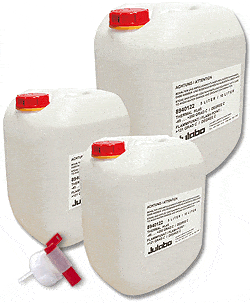
Julabo Thermal C10
Julabo Thermal C10 JULABO Thermal bath fluids are ideally suited for all of your temperature control applications and guarantee safe and reliable operation. Choosing the proper bath fluid is critical for the best temperature control results. Viscosity, oxidation characteristics and heat transfer of Thermal fluids are matched specifically with each JULABO temperature control unit. JULABO Thermal bath fluids have been carefully selected and optimized for maximum performance with JULABO instruments. Thermal C10 is a clear 10 cSt silicone fluid rated for use in open bath JULABO units with a working temperature range of -20…+160 °C. Care should be taken to observe atmospheric moisture condensation in the bath fluid with prolonged sub-ambient operation in humid environments. Water and silicone fluids are not miscible. Operation at the maximum temperature for heating applications will result in vapor formation. Vapor formation at elevated temperatures is a normal occurrence for silicone fluids. The upper temperature limit of the fluid is lower than the fluid flashpoint.
$2,275.43 - $4,519.50
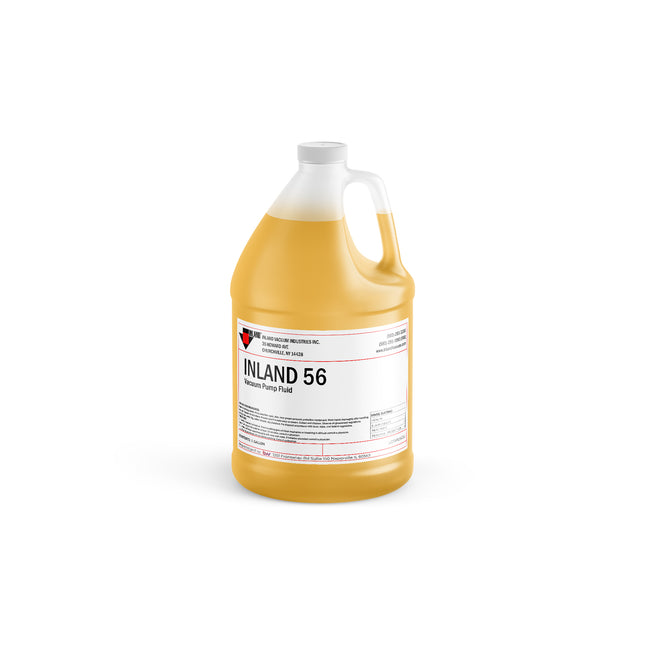
Inland 56 Vacuum Pump Oil (LVO 200)
Inland 56 Vacuum Pump Oil The Inland 56 is an equivalent to the Leybold LVO 200 oil. This oil can be used in pumps specifically designed for pumps that use the Leybold LVO 200 oil. Inland 56 Vacuum Pump Oil Safety Data Sheet SDS
$32.79 - $5,439.08
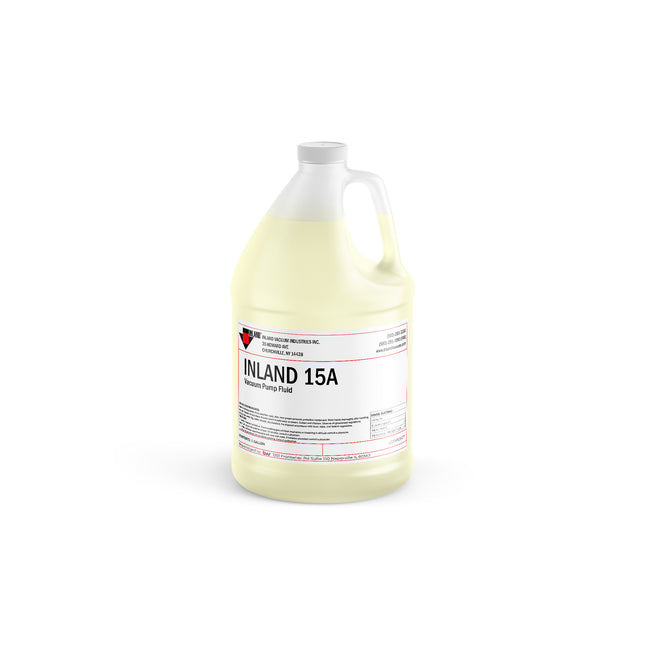
Inland 15A Vacuum Pump Oil
Inland 15A Vacuum Pump Oil Inland 15A Vacuum Pump Oil Safety Data Sheet SDS
$21.39 - $1,988.86





















